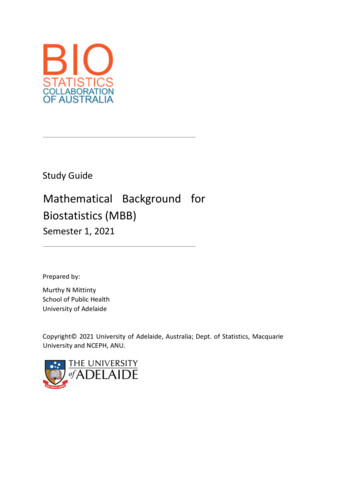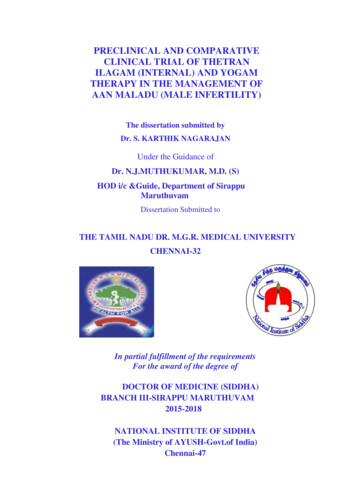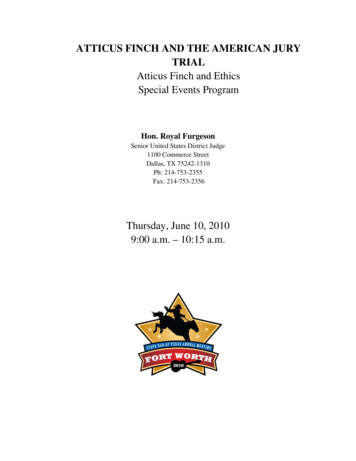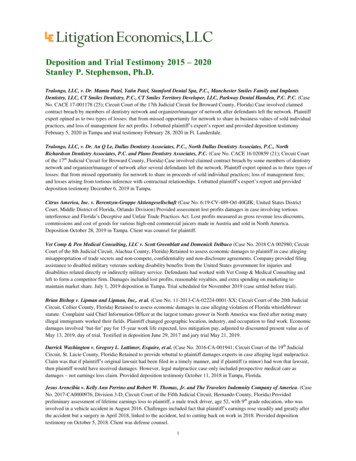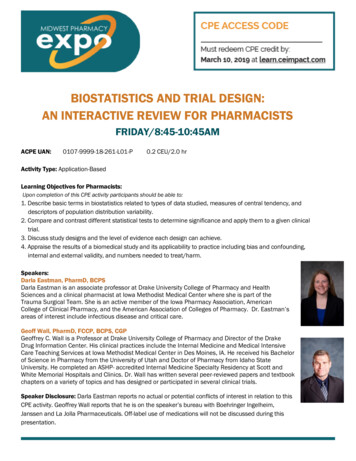
Transcription
BIOSTATISTICS AND TRIAL DESIGN:AN INTERACTIVE REVIEW FOR PHARMACISTSFRIDAY/8:45-10:45AMACPE UAN:0107-9999-18-261-L01-P0.2 CEU/2.0 hrActivity Type: Application-BasedLearning Objectives for Pharmacists:Upon completion of this CPE activity participants should be able to:1. Describe basic terms in biostatistics related to types of data studied, measures of central tendency, anddescriptors of population distribution variability.2. Compare and contrast different statistical tests to determine significance and apply them to a given clinicaltrial.3. Discuss study designs and the level of evidence each design can achieve.4. Appraise the results of a biomedical study and its applicability to practice including bias and confounding,internal and external validity, and numbers needed to treat/harm.Speakers:Darla Eastman, PharmD, BCPSDarla Eastman is an associate professor at Drake University College of Pharmacy and HealthSciences and a clinical pharmacist at Iowa Methodist Medical Center where she is part of theTrauma Surgical Team. She is an active member of the Iowa Pharmacy Association, AmericanCollege of Clinical Pharmacy, and the American Association of Colleges of Pharmacy. Dr. Eastman’sareas of interest include infectious disease and critical care.Geoff Wall, PharmD, FCCP, BCPS, CGPGeoffrey C. Wall is a Professor at Drake University College of Pharmacy and Director of the DrakeDrug Information Center. His clinical practices include the Internal Medicine and Medical IntensiveCare Teaching Services at Iowa Methodist Medical Center in Des Moines, IA. He received his Bachelorof Science in Pharmacy from the University of Utah and Doctor of Pharmacy from Idaho StateUniversity. He completed an ASHP- accredited Internal Medicine Specialty Residency at Scott andWhite Memorial Hospitals and Clinics. Dr. Wall has written several peer-reviewed papers and textbookchapters on a variety of topics and has designed or participated in several clinical trials.Speaker Disclosure: Darla Eastman reports no actual or potential conflicts of interest in relation to thisCPE activity. Geoffrey Wall reports that he is on the speaker’s bureau with Boehringer Ingelheim,Janssen and La Jolla Pharmaceuticals. Off-label use of medications will not be discussed during thispresentation.
1/23/2019“Lies, Dang* Lies, and Statistics”:Biostatistics and Trial Design: AnInteractive Primer for Pharmacists* apologies to TwainPresented by:Geoffrey C. Wall, Pharm.D., FCCP, BCPSDarla Eastman, Pharm.D., BCPSProfessor of Pharmacy Practice, Drake UniversityAssociate Professor of Pharmacy Practice, Drake UniversityInternal Medicine Clinical PharmacistTrauma Clinical PharmacistIowa Methodist Medical CenterIowa Methodist Medical Center1Disclosure Geoff Wall reports no actual or potential conflicts of interest associated withthis presentation Darla Eastman reports no actual or potential conflicts of interest associatedwith this presentation21
1/23/2019Learning Objectives Upon successful completion of this activity, participants should beable to: Describe basic terms in biostatistics related to types of datastudied, measures of central tendency, and descriptors ofpopulation distribution variability Compare and contrast different statistical tests to determinesignificance and apply them to a given clinical trial Discuss study designs and the level of evidence each designcan achieve Appraise the results of a biomedical study and its applicability topractice including bias and confounding, internal and externalvalidity, and numbers needed to treat/harm3Case #1 As a hospital pharmacist you are asked to review a drug for yourhospital’s P&T Committee This drug, just approved by the FDA, has two major Phase 3 studiespublished to date In the “statistics” section of the paper the authors used numeroustests you have never heard of Do you assume that “since the journal approved the paper forpublication, the stats must be correct?42
1/23/2019Lies er, Misconceptions aboutBiostats Only statisticians can understand them NOT true, understanding basic biomedical stats and trial design is not difficult If a paper is published in a peer-reviewed journal the stats are ok In many cases statistics are only given a cursory glance in peer-review Every paper needs a statistician among the authors or the stats aresuspect It certainly helps to, but again, BASIC stats are not difficult to do Like everything else in Pharmacy, getting good at reviewing studiestakes practice more than anything else5The purpose of this session Review basic concepts of biostats: Types of data, measures of central tendency, populations, hypothesis testing Review different types of evidence/studies RCT vs Cohort vs Case control Review types of statistical tests Pearls for reviewing studies This is just a BASIC review. Far more detailed study activities doexist for those interested63
1/23/2019Case #2 As a independent pharmacy owner you have decided to add inhome delivery of medications to the services provided. To get anidea of the scope and success of this service you ask the patientswho fill prescription to take a quick 4 question survey. Eachquestion uses a Likert (1-5) scale to assess the feelings yourpatients have about this service What type of data is this?7Types of data Dictates Measures of central tendency Appropriate statistical test to use84
1/23/2019Types of Data Nominal Data: Dichotomous data, Discrete data e.g.: yes or no, alive or dead, pet owner or not Ordinal Data: Ranked data with no level of concrete measurementbetween levels Discrete data e.g. NYHA, Most Likert scales, APACHE II, Ramsay scale of sedation, etc. Interval Data: Data in specific order with defined levels of magnitude, butno set point for zero Continuous data e.g. Degrees Fahrenheit—this is rarely used in the biomedical literature Ratio Data: Interval data with a fixed zero Continuous data e.g. blood pressure, time, pulse, etc.9Case #2 As a independent pharmacy owner you have decided to add inhome delivery of medications to the services provided. To get anidea of the scope and success of this service you ask the patientswho fill prescription to take a quick 4 question survey. Eachquestion uses a Likert (1-5) scale to assess the feelings yourpatients have about this service What type of data is this?105
1/23/2019Case #3 As an independent pharmacist you and your tech are reviewing timeto receiving payments from PBMS (stop laughing ). Of the 15PBMs you review 13/15 will reimburse sometime within day 1 andday 28 of the claim (I said STOP LAUGHING) and 2/15 takebetween 28 and 60 days to reimburse What is the best measure of central tendency to describe this data?11Mean (μ) The arithmetic average (add allof the scores together, thendivide by the number of scores) μ x / n126
1/23/2019Median The middle number (just likethe median strip that divides ahighway down the middle;50/50) Used when data is not normallydistributed Often hear about the medianprice of housing13Mode The most frequently occurringnumber (score, measurement,value, cost) On a frequency distribution, it’sthe highest point (like the á lamode on pie)147
1/23/2019Standard Deviation (σ)15Case #3 As an independent pharmacist you and your tech are reviewing timeto receiving payments from PBMS (stop laughing ). Of the 15PBMs you review 13/15 will reimburse sometime within day 1 andday 28 of the claim (I said STOP LAUGHING) and 2/15 takebetween 28 and 60 days to reimburse What is the best measure of central tendency to describe this data?168
1/23/2019Confidence Intervals (CI)Confidence Interval: An interval of values computed fromthe sample, that is almost sure to cover the true populationvalue.We make confidence intervals using values computed from the sample, notthe known values from the populationInterpretation: In 95% of the samples we take, the truepopulation proportion (or mean) will be in the interval.This is also the same as saying we are 95% confident that the truepopulation proportion (or mean) will be in the intervalSO if 1 (or “parity”) is in the CI of a result we are saying that “nodifference” is as statistically likely to the real answer as the one foundThis means NO statistical difference in the result (no p-value needed!)17So what? In most clinical trials it is these measures of central tendency thatare compared against each other in clinical trials Mean blood pressure decrease between two drugs Median time to remission of disease in a chemotherapy regimen Modes actually rarely used in clinical trials189
1/23/201919Case #4 A industry representative speaks to the director of a hospitalpharmacy about a new drug for acute lowering of blood pressureafter a head injury. The paper she brings to review compares 40patients with a head injury who received either standard of care(SOC) or her company’s new drug. Mean SBP decreased 19mmHg with the SOC and 13 mmHg with the new drug (p 0.05).She claims that “both drugs are equal in lowering BP” What could be a possible flaw in this study?2010
1/23/2019We make mistakes!Alpha levelp value Set BEFORE we collect data,run statistics Calculated AFTER we gatherthe data Defines how much of an errorwe are willing to make to saywe made a difference If we’re wrong, it’s an alphaerror or Type 1 error The calculated probability of amistake by saying it works AKA: level of significance Describes the percent of thepopulation/area under thecurve (in the tail) that is beyondour statistic21β Error and Power Type II Error (β) False Negative In other words not finding a difference between groups when one, in fact,exists, Power is the probability of making a correct decision when the NullHypothesis (Ho) is false In other words, can you detect a difference if one exists Power is increased by: increasing n, increasing alpha, increasingdifferences between populations2211
1/23/2019Case #4 A industry representative speaks to the director of a hospitalpharmacy about a new drug for acute lowering of blood pressureafter a head injury. The paper she brings to review compares 40patients with a head injury who received either standard of care(SOC) or her company’s new drug. Mean SBP decreased 19mmHg with the SOC and 13 mmHg with the new drug (p 0.05).She claims that “both drugs are equal in lowering BP” What could be a possible flaw in this study?232-Tailed Test The critical value is the number thatseparates the “blue zone” from themiddle ( 1.96 this example) In a t-test, in order to be statisticallysignificant the t score needs to be inthe “blue zone” If α .05, then 2.5% of the area is ineach tail2412
1/23/20191-Tailed Test The critical value is either or -,but not both. In this case, you would havestatistical significance (p .05)if t 1.645.25Case #5 You are writing a P&T monograph for your hospital’s formularycommittee concerning one of the new PCSK9 drugs forhypercholesterolemia. One of the papers you read is a “smallcrossover study where participants are given one dose of the drugor placebo, had their lipid profiles measured and then 1 week latergiven the opposite treatment (the active drug group now getsplacebo and vice-versa) What issues would you have concerning the accuracy of this study?2613
1/23/2019General Study Designs Many clinical trial study designs fall into thecategories of parallel group, dose-ranging,cross-over and factorial designs There are many other possible designs andvariations on these designs27General Study Designs Parallel group designsARANDBCcontrol2814
1/23/2019General Study Designs Dose-Ranging Studieshigh doseRANDmedium doselow dosecontrol29General Study Designs Cross-Over DesignsW AS H -OU TRANDABBA3015
1/23/2019General Study Designs Factorial DesignsA BRANDA controlB controlcontrol contro l31Cross-Over Designs Subjects are randomized to sequences oftreatments (A then B or B then A) Uses the patient as his/her own control Often a “wash-out” period (time betweentreatment periods) is used to avoid a “carryover” effect (the effect of treatment in the firstperiod affecting outcomes in the secondperiod) Can have a cross-over design with more than2 periods3216
1/23/2019Cross-Over Designs Advantage: treatment comparison is onlysubject to within-subject variability notbetween-subject variability reduced sample sizes, so easier andcheaper to do Disadvantages: strict assumption about carry-over effects inappropriate for certain acute diseases (where a conditionmay be cured during the first period) drop outs before second period33Cross-Over Designs Appropriate for conditions that are expected to return tobaseline levels at the beginning of the second periodExamples: Treatment of chronic pain Comparison of hearing aids for hearing loss Mouth wash treatment for gingivitis3417
1/23/2019Case #5 You are writing a P&T monograph for your hospital’s formularycommittee concerning one of the new PCSK9 drugs forhypercholesterolemia. One of the papers you read is a “smallcrossover study where participants are given one dose of the drugor placebo, had their lipid profiles measured and then 1 week latergiven the opposite treatment (the active drug group now getsplacebo and vice-versa) What issues would you have concerning the accuracy of this study?35Factorial Designs Attempts to evaluate two interventions compared to acontrol in a single experiment (simplest case) An important concept for these designs is interaction(sometimes called effect modification) Interaction: The effect of treatment A differs dependingupon the presence or absence of intervention B and viceversa.3618
1/23/2019Factorial Designs Advantages: If no interaction, can perform two experiments with less patients thanperforming two separate experiments Can examine interactions if this is of interest Disadvantages: Added complexity potential for adverse effects due to “poly-pharmacy”37Factoria
BIOSTATISTICS AND TRIAL DESIGN: AN INTERACTIVE REVIEW FOR PHARMACISTS FRIDAY/8:45-10:45AM ACPE UAN: 0107-9999-18-261-L01-P 0.2 CEU/2.0 hr Activity Type: Application-Based Learning Objectives for Pharmacists: Upon completion of this CPE activity participants should be able to: 1. Describe basic terms in biostatistics related to types of data studied, measures of central tendency,

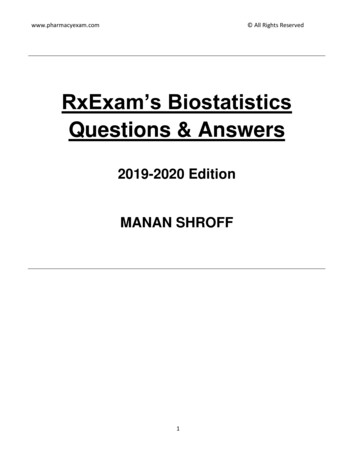
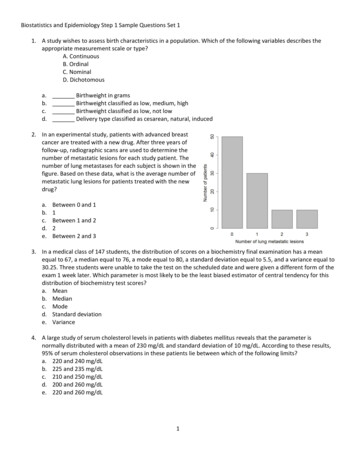
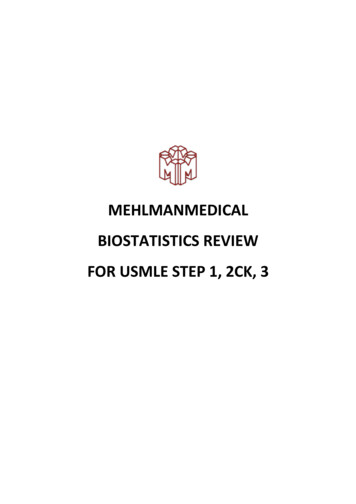
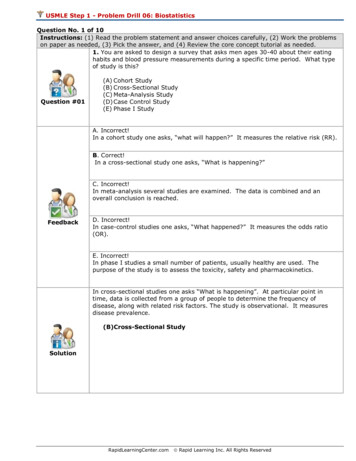
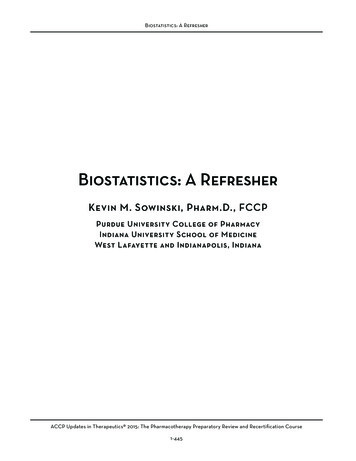
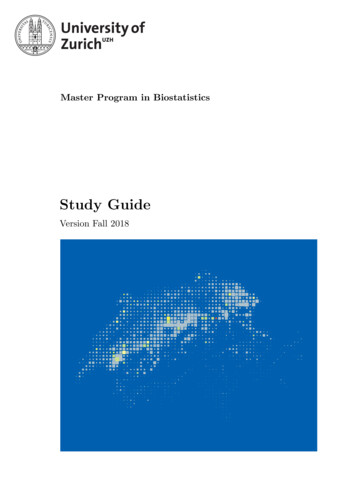
![Clinical Biostatistics [CLB]](/img/6/study-guide-clb-2021.jpg)
